Money - a Medium
of Exchange
Barter as the Basic
Event
Here we will not
pick up the quarrel of economists whether money has come into existence
with the exchange of goods or whether something else had given rise to
it. Moreover, we start off from our present reality and claim that economy
is mainly concerned with the exchange of work. In the goods, too, which
we use for our everyday needs we primarily appreciate the work that was
necessary for its production. The evaluation of work depends on various
factors which shall not be investigated here either.
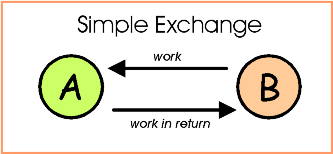 A
barter deal consists of work and work in return. If the value of two exchanged
services or goods is considered equal, then the barter is accomplished. The
event does not have to be documented.
A
barter deal consists of work and work in return. If the value of two exchanged
services or goods is considered equal, then the barter is accomplished. The
event does not have to be documented.
However, this is not the
normal case in our economy of divided labour. Labour division means specialization
and the difficulty to find a partner who offers the desired product in
return. In this case a reliable and credible means of documention will
be required.
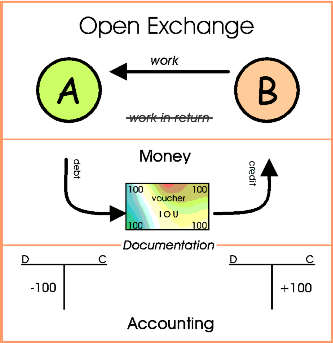 When
a barter deal remains open, then this means that some work had been performed,
but no service or goods had been returned. This is the regular case in our
economy of labour division. Now, the missing work in return has to be documented
in such a way that another participant in the economy who is willing to return
a service or goods, has an idea of how much the requiring person is entitled
to demand.
When
a barter deal remains open, then this means that some work had been performed,
but no service or goods had been returned. This is the regular case in our
economy of labour division. Now, the missing work in return has to be documented
in such a way that another participant in the economy who is willing to return
a service or goods, has an idea of how much the requiring person is entitled
to demand.
There are two ways of documentation:
accounting and money.
In accounting the
amount will be entered on two sides: on the account of the receiver A as
minus amount and on the account of the giver B as plus amount. Believers
in the creation of "bookmoney" would say in this case that money had been
"created". But this is misleading because money is a different kind of
documentation.
Money in its most
original form is a promissory note which in our example is being issued
by Mr. A. He notes on the paper that he is willing to return a service
or good equivalent to the one he had received. For Mr. B, however, this
IOU is a voucher which enables him to prove to a third person that he is
owed a return.
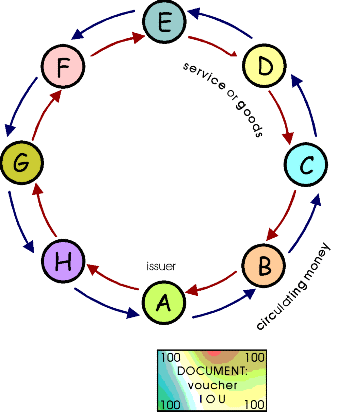 In
this rather simplified scheme we can easily comprehend how such a voucher-IOU
"runs around". Let's assume that Mr. B is a barber who cuts Mr. A's hair.
Mr. A has brought along a nice glass of self-made strawberry jam which he
wanted to give in exchange. The barber Mr. B, however, doesn't like strawberry
jam and refuses to take it. Thus the direct exchange fails, it remains open.
In a barter-ring they would now take their account booklets and enter their
respective debt or credit.
In
this rather simplified scheme we can easily comprehend how such a voucher-IOU
"runs around". Let's assume that Mr. B is a barber who cuts Mr. A's hair.
Mr. A has brought along a nice glass of self-made strawberry jam which he
wanted to give in exchange. The barber Mr. B, however, doesn't like strawberry
jam and refuses to take it. Thus the direct exchange fails, it remains open.
In a barter-ring they would now take their account booklets and enter their
respective debt or credit.
There is yet a more practical
option: Mr. A confirms on a paper that Mr. B had cut his hair which is
as much worth as a nice glass of strawberry jam. He promises to hand the
strawberry jam over to the bringer of this paper which means to fulfill
his service in return. Mr. B agrees and takes the paper instead of the
service in return. He then goes to the cheese vendor Mrs. C and asks her
to give him as much cheese as he can ask for a haircut or a glass of strawberry
jam. Mrs. C takes the paper but doesn't like strawberry jam either. She
goes to the wine dealer Mr. D and gets a bottle of wine. Mr. D, too, isn't
fond of marmelade and gives the voucher-IOU to Mr. E for repairing his
washing machine.
In this way the paper runs
from hand to hand until it finally reaches Mrs. H who is in desperate need
of strawberry jam. She goes to Mr. A and asks for the glass of jam in return
for sewing Mr. G's coat. Thus, the circle closes in the end, which, of
course, could have been much wider until Mr. Q or Mr. Z or even further.
There are no restrictions as to the size of this circle.
Basically, such a circular
deal may also be done by accounting. Double accounting, however, is much
more troublesome. Even though electronic accounting has made things much
easier, the conventional money in form of bank notes or coins will probably
survive and will be changed into an appropriate electronic version of "reloadable"
cash-cards. Money closes and opens a barter deal with every change of hands.
In contradistinction to personal promissory notes with entered names, money
is an arbitrarily transferable blank voucher-IOU for a standardized value.
The owner of a bank note is the one who has credit in an open barter deal
and everyone else who is willing to offer some service or goods is sort
of discharging his "debts".
Accounting versus Money
As far as the payment
function is concerned, accounting is much better apt for big sums. If someone
buys a house or a car, he will probably not pay by handing over a suit
case full of cash. On the other hand, the price of eggs for breakfast,
a new ball point pen or a new pair of socks will not be paid by accounting,
because it is just awkward and expensive. Accounting has a more static
character, a status is documented even though this status may be momentary.
More important is another
difference between accounting and money: there is no controllable "money
amount" in accounting. Accounting will be used, when a deal remains open,
i.e. when there is no direct response to a service. The open deal results
in two sides: debt and credit. The balance of debts and credits is always
zero, and the sum of debts or credits arises according to the needs and
may fluctuate. This is not so with money. The person with a bill in his
hand has credit and is entitled to receive a service in return. He just
has to find someone who is ready to accept the role of a "debtor". In an
economy with labour division this is usually not difficult, since every
producer of certain goods or services is interested in receiving a means
of exchange which allows him to get the things, which he cannot produce
himself. Thus, money can "translate" the work of an engineer into that
of a farmer or the work of a roofer into that of a medical doctor. Money
has a dynamic character. A rough picture for the circulation of money might
be the millwheel which is turned around by the current. The river symbolizes
the stream of goods and services which flows in one direction from the
producer to the consumer. The money corresponds to the millwheel steadily
being moved by the current. The millwheel (the money supply) turns around
its axe while its vanes (bank notes) continuously dip into the water. Well,
metaphors like that of the millwhell have to be taken with a grain of salt.
In economy it's just the other way around: a repeated handing over of money
results in the turnover of goods and services, so it's the money which
actively keeps the stream moving. The size of the money supply can be fixed
with small fluctuations while the stream of goods and services continuously
flows in one direction. Debts and credits may wax and wane in the course
of longer periods corresponding to the "water level" while the circulation
speed of money can adapt immediately to changing conditions.
Money supply, circulation
speed and current of goods (turnover) are tightly interrelated. Relative
prices develop through the circulating amount of money in relation to the
stream of goods. Price stability can only be ensured if the relation of
money supply multiplied by circulation speed is dynamically adjusted to
the stream of goods and services. This is possible only if all the parameters
of the equation are known and can be adjusted. In the existing monetary
system it is mainly the circulation speed the fluctuations of which can
not be calculated.
Money Emission out of
the Void
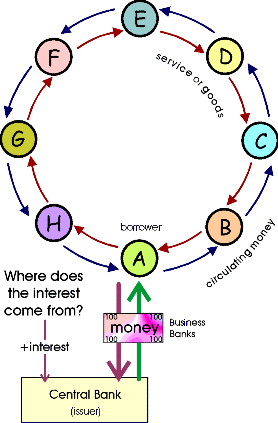 This
again is a very simplified scheme for the issuing of money by conventional central
banks. The central or issuing banks are the only ones which are licensed to
print money bills and put it in circulation. They create money out of the void
and lend it out as credit in exchange for bonds or other valuables which can
be redeemed with the respective amount of money. In former times the issued
money was backed by gold ingots which the central bank bought and deposited
in its safe. These gold ingots could be redeemed on demand by returning the
issued paper notes. Since gold has a rather low utility value and the storing
in private safes is not very attractive either - it doesn't earn interest there
-, the demand for gold ingots was next to nul.
This
again is a very simplified scheme for the issuing of money by conventional central
banks. The central or issuing banks are the only ones which are licensed to
print money bills and put it in circulation. They create money out of the void
and lend it out as credit in exchange for bonds or other valuables which can
be redeemed with the respective amount of money. In former times the issued
money was backed by gold ingots which the central bank bought and deposited
in its safe. These gold ingots could be redeemed on demand by returning the
issued paper notes. Since gold has a rather low utility value and the storing
in private safes is not very attractive either - it doesn't earn interest there
-, the demand for gold ingots was next to nul.
This backing by gold, however,
resulted in a fatal confusion. Money became a symbol for gold which doesn't
rust, oxidize or rot - it's seemingly immortal. Thus, money inherited the
features of gold especially its everlastingness. All real objects of exchange
(except very few), however, commodities, consumer items and services are
subject to natural decay, they have to be used up, maintained or renewed.
Since money serves as a means of exchange for decaying goods, it should
also document this loss in value of ordinary goods of exchange. Otherwise
a discrepancy arises between documented values on the one hand and real
values on the other. Real goods lose value in time, while documented values
even seem to be able to grow with compound interest.
This mechanism which had
been set going by the central banks can now be used for the benefit of
private persons who accumulate money and lend it out for interest. They
withdraw the necessary medium of exchange from the market and demand ransom
money for returning it. The interest rate on the capital market is higher
than that of the central banks. It already contains a compensation for
the expected inflationary devaluation. Since the creeping inflation is
more or less a linear devaluation, it cannot really counter the exponential
growth of monetary assets induced by compound interest. This results in
the cancer-like rank growth of private monetary capital which in the end
does not represent real worth anymore, for the documented everlasting values
are not in accordance any more with the value of the real goods.
The Medium of Exchange
as Public Service
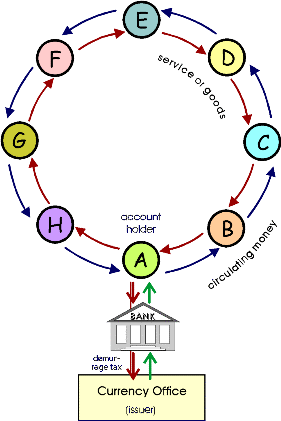 In
contra distinction to the traditional practice, Gesell has suggested to provide
money as a public service. This can be done by a neutral institution like for
instance a "currency office" as Gesell called it. This institution is not a
bank which lends out loans, but just puts a medium of exchange at the disposal
of the participants in the economy who are in need of a document for a given
service and are entitled for a service in return. This documentation system
is understood as a public service which like any other service as well is liable
to a charge. The money supply is slightly reduced by the user charge which
is returned to the currency office. The main task of the currency office is
to watch the stability of the purchasing power. Then it can decide, whether
this amount of money will be fed back in the economy or not. The only relevant
considerations in this respect are in favour of the preservation of the purchasing
power of the currency. The user fee has the additional effect that the circulation
speed of money becomes steady and a calculable factor. The private hoarding
of the public medium of exchange is not beneficial anymore because it can not
extort interest and this results in the steadiness of circulation. Money is
only a medium of exchange and a measure for prices but no means anymore for
extorting income without work.
In
contra distinction to the traditional practice, Gesell has suggested to provide
money as a public service. This can be done by a neutral institution like for
instance a "currency office" as Gesell called it. This institution is not a
bank which lends out loans, but just puts a medium of exchange at the disposal
of the participants in the economy who are in need of a document for a given
service and are entitled for a service in return. This documentation system
is understood as a public service which like any other service as well is liable
to a charge. The money supply is slightly reduced by the user charge which
is returned to the currency office. The main task of the currency office is
to watch the stability of the purchasing power. Then it can decide, whether
this amount of money will be fed back in the economy or not. The only relevant
considerations in this respect are in favour of the preservation of the purchasing
power of the currency. The user fee has the additional effect that the circulation
speed of money becomes steady and a calculable factor. The private hoarding
of the public medium of exchange is not beneficial anymore because it can not
extort interest and this results in the steadiness of circulation. Money is
only a medium of exchange and a measure for prices but no means anymore for
extorting income without work.
Interest versus Demurrage
Tax
Sometimes the demurrage
tax according to Gesell is also called »minus interest« which
is slightly misleading because the function and the effects are quite different.
In both models for the introduction of money into the economic cycle a
fee is being charged: in the existing system it is the interest which is
not only charged on the circulating money but on monetary assets alike.
Therefore it continuously enforces the expansion of monetary assets and
exponential growth which is bound to crash. In the model according to Gesell
the fee is charged on the circulating money only and does not enforce unrealistic
and unhealthy growth.
Another important difference
is that the demurrage tax is only due for the time the owner holds it in
his hands. On a current account it is only due to that extent the bank
has to hold cash money in order to satisfy the demands of their clients
for cash. Long term deposits which the bank can grant as loans are free
from demurrage tax. Interest on a loan, however, is due as long as it is
not paid back no matter whether the money from the credit is kept in hands
or circulating in the economy.
In the existing system interest
causes the transfer of wealth from the working to the not-working. In this
way ever growing debts and credits arise which split the society in a minority
of super-rich and a majority of poor people. On the contrary the demurrage
tax is only due for the circulating amount of money and not for the turnover
of goods and services. In relation to the real turnover it only plays a
minor role and does not affect the prices.
The function of the demurrage
tax is to neutralize the superiority of the medium of exchange over
the objects of exchange. Medium of exchange and objects of exchange are
at an equal level. Minus interest would it be if the demurrage tax rate
is
higher than the superiority difference relative to the objects of exchange.
This means money would become inferior to the objects of exchange.
But the demurrage tax only serves to neutralize the original interest (»Urzins«)
according to Gesell or the liquidity premium according to Keynes.
© 2000 Robert Mittelstaedt
A
barter deal consists of work and work in return. If the value of two exchanged
services or goods is considered equal, then the barter is accomplished. The
event does not have to be documented.
When
a barter deal remains open, then this means that some work had been performed,
but no service or goods had been returned. This is the regular case in our
economy of labour division. Now, the missing work in return has to be documented
in such a way that another participant in the economy who is willing to return
a service or goods, has an idea of how much the requiring person is entitled
to demand.
In
this rather simplified scheme we can easily comprehend how such a voucher-IOU
"runs around". Let's assume that Mr. B is a barber who cuts Mr. A's hair.
Mr. A has brought along a nice glass of self-made strawberry jam which he
wanted to give in exchange. The barber Mr. B, however, doesn't like strawberry
jam and refuses to take it. Thus the direct exchange fails, it remains open.
In a barter-ring they would now take their account booklets and enter their
respective debt or credit.